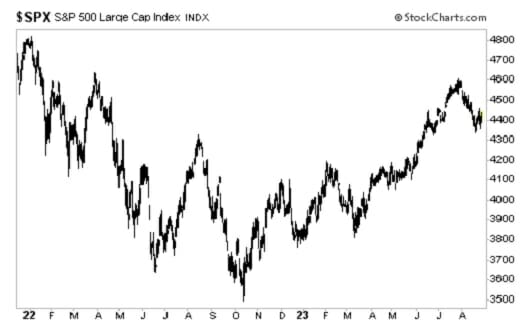The Worst Month Of The Year For Stocks: Time To Sell?
The stock market has steadily marched towards its high set in January 2022. In fact, it’s only about 8% away from a new all-time high.
The steady market rise has also been good for our portfolio over at Top Stock Advisor. Many of our holdings are beating the market’s robust 15% year-to-date return.

For example, the backbone of the internet, Cisco Systems (Nasdaq: CSCO), is up over 18% on the year (thanks to an earnings beat in its latest quarter).
Alphabet (Nasdaq: GOOGL) has jumped 48% this year. But they aren’t alone. Other holdings are up 21%, 23%, and 37% year-to-date. And even our home builder pick has soared 34%.
Then there’s the leader of the pack — Meta Platforms (Nasdaq: META) — which is up a staggering 143%.
We recently decided to take advantage of this rally and do a little portfolio cleanse. Why? Well, as I’ll touch on in a moment — selling is one of the hardest things to do as an investor. That alone is a good reason.
But we’re also entering September. Let me explain…
The Worst Month Of The Year
Why September, you might ask? Well, over the past 10 years, September and January have been the two worst months for stocks (as measured by the S&P 500).
What am I talking about? Seasonality.
Stock market seasonal patterns are the directional tendencies of stock indices based on the time of year. Yes, we investors are always looking for an edge. In addition to seasonality, there’s the Presidential Election Cycle Theory and a host of other data we pull to try and figure out what stocks are going to do.
I’m going to touch on seasonality.
Certain times of the year tend to be more bullish for stocks, while other times are more bearish (think of the saying “Sell in May and go away”). This is all based on historical data, not Tarot card readings, so it has some validity.
Anyways, over the last 10 years, here is how the S&P 500 has performed.

This chart shows the percentage for each month the S&P 500 closed higher than it opened. For example, 90% of the time over the past 10 years, April and May have closed higher than where the month started (very bullish months).
Then you see the weakling of the bunch… September.
September has ended on a positive note just 33% of the time.
Will this year be different? I have absolutely no idea (nobody does). But we can see from this data that September is a weak month historically. So, if you’re looking to book some profits, it might be best to do so before September rolls around.
Why Knowing When To Sell Is Important
With all this in mind, it had been some time since we’ve really cleaned house in our portfolio. So that’s exactly what we did. Most of the stocks we sold were in the red (although we did book a few profits). But cutting losers is imperative to becoming a better investor.
If you don’t believe me, take it from Jesse Livermore, one of the most well-known traders in the history of Wall Street.
“Losing money is the least of my troubles. A loss never troubles me after I take it. I forget it overnight. But being wrong — not taking the loss — that is what does the damage to the pocket book and to the soul.” — Jesse Livermore, Reminiscences of a Stock Operator
If you’re unfamiliar with Livermore’s story, I encourage you to look it up. But you need to know this guy made a fortune (and lost it) many times over. So he knows what he’s talking about.
It’s no secret that one of the hardest things to figure out is the right time to sell. This is especially true if you’re sitting on a loser.
If a stock goes down, we quietly tell ourselves that we will sell as soon as it gets back to even. We also lie to ourselves by telling ourselves that we are “buy and hold” investors and are in it for the long haul. But as the stock sinks lower and lower, it usually doesn’t work out too well.
Pretty soon, you’re sitting on a 20%, 30%, 50% loss, or worse.
Why does this happen? Because selling admits failure, and we’re hard-wired to not accept failure.
But you’ll be much better off if you can swallow your pride, put your ego to the side, and cut your loss. Trust me.
Closing Thoughts
How much of a loss can you afford to sit on in your portfolio? 20%? 30%? 50%? What’s the point where you say “uncle”? Really think about it. Remember, you need to make 100% to recover from a 50% loss. That’s just to break even. And triple-digit winners don’t exactly grow on trees.
Bottom line, it might not be a bad idea to take advantage of this rally and prune your portfolio. Get rid of some dead weight.
But the larger lesson here is this…
Figure out the most you are willing to lose on a stock before you even enter the trade. Have an exit strategy in place. And if you need to, use a stop-loss or a trailing-stop to hold yourself accountable.
P.S. Our team thinks a select few cryptos are about to go on another monster run. So if you missed the boat on previous big rallies, you can still profit. To learn more, go here now…
